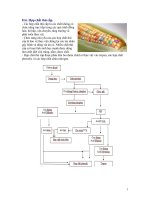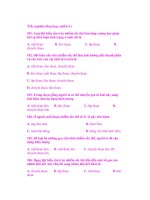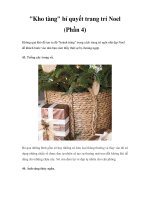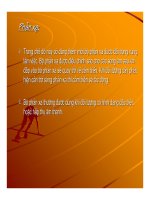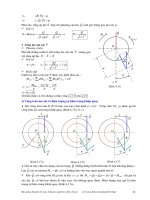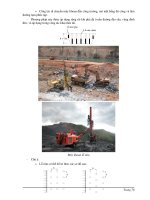Energy Management Handbook for Homeowners phần 4 ppsx
Bạn đang xem bản rút gọn của tài liệu. Xem và tải ngay bản đầy đủ của tài liệu tại đây (119.57 KB, 11 trang )
30
Steps to Reduce Excessive Humidity
Recognize that the best way to stop condensation is to reduce the moisture in the inside air. Eliminate or reduce any
sources of moisture in your home that you can control.
1. Be sure that attic or crawl spaces are properly ventilated. Add a vapor barrier to cover the earth in the crawl space.
2. If you have single-pane windows, install storm panels, double-pane insulating glass or triple-glazed panels.
3. In winter, provide more controlled ways for moist inside air to get out. Run kitchen and bathroom ventilating fans
during periods of moisture production.
4. Vent your clothes dryer to the outside.
5. Address water problems such as seepage from the outside, leaks in a roof or walls, and leaky pipes.
Moisture
Moisture Production
Source Water Vapor Produced
Human respiration by an average family of four 8 to 12 pounds in 24 hours
Cooking for an average family of four on a gas range 5 pounds per day
Showering 1/2 pound per shower
Tub bath 1/8 pound per bath
Clothes drying 1 pound of water per pound of dry clothes (if dried
inside or dryer is not vented)
Living plants About the same produced in watering the plants
Unvented gas heater (each 100,000 Btus or each therm) 8 to 10 pounds
Humidifier Nameplate rating of unit
Be Careful When Installing Insulation
Excessive moisture in the home filters through insulation and causes it to become damp and matted and to lose much
of its effectiveness.
To prevent or reduce condensation problems, the side of the insulation exposed to high vapor pressure (warm side in
winter) must be covered with material that will impede the natural drive of moisture to flow through the inside surfaces of
exterior walls, toward the lower vapor pressure outside. To be effective, such a material must have a high resistance to
moisture flow. The material is usually called “vapor barrier” or “vapor retarder.”
New Construction
• Choose wood or vinyl-sheathed wood rather than metal for windows and gliding doors. This will reduce the likelihood
of condensation on the frame and sash. Wood is a better insulator than metal. Metal frames without thermal breaks
conduct heat readily, so the inside surface of a metal window frame is cold in the winter. When humid air comes into
contact with cold metal, condensation, and often freezing, occurs.
• Make sure the attic and crawl space are cross-ventilated. The crawl space should be covered with a vapor barrier.
This will prevent water vapor from rising from the soil into your house.
• Make sure your clothes dryer and all gas appliances are vented to the outside. Water vapor is one of the products of
gas combustion.
• If you have a basement, take the necessary steps to prevent leakage of soil moisture into the basement. These
steps will vary with soil and drainage conditions on your lot.
31
Attic Ventilation
Ventilation of an attic or crawl space is very important to allow warm, moist air to escape to the outdoors.
If the insulation in your attic has a vapor barrier (which should be toward the floor, and not on top of the insulation
where it may trap moisture), you should have at least one square foot of free vent opening (measurement of the opening
not including the area taken up by screen or grillwork) for each 150 square feet of floor area. The net, free vent area
should be specified on the vent itself, or the information should be available from the vendor. It is preferable that the
vents be located such that one-half of the vents are low and one-half are high.
Don’t try to substitute a vapor barrier for ventilation. According to Department of Housing and Urban Development
standards, if you have a vapor barrier, you should still have one square foot of free vent opening for every 300 square
feet of attic floor opening.
Turbine vents and attic ventilating fans are also useful for ventilation.
Note: Take care to install enough attic ventilation to meet the needs of your whole-house fan. Requirements should
be listed on the instruction sheet or available from the manufacturer or vendor of the fan.
Wintertime Attic Ventilation
If the house is insulated, attic ventilation should not be covered in the winter. If warm, moist air in the attic condenses
on the roof decking, it may melt and drip on attic insulation, causing the insulation to be ineffective. Warm air in the attic
can also cause other roof problems.
Crawl Spaces
Crawl spaces should be vented to the outdoors in the summer. If the vents are located near each corner, the vents
will permit good air movement through the crawl space. The total of all the vent areas where there is no vapor barrier as
a ground cover should be at least one square foot for each 150 square feet of floor area. Where such a vapor barrier is
used, the vent area may be reduced to 1/1,500 of the floor area.
Crawl space vents should be closed and sealed in the winter. Exception: When vents are used for combustion air-to-
gas appliances located in the crawl space.
Note: If your foundation walls are insulated, the vents should have insulation placed over them in winter.
Ventilation Attic & Crawl Space
32
Water heating is the third largest energy expense in the home, behind heating and air conditioning. Because a
water heater is one of the large energy users, EnergyGuide labels are required. The labels are good guides for choosing
the most efficient model you can afford.
The fuel you use to heat water is a big factor in water heating costs. If you have an electric water heater, the cost is
probably two to three times as much.
When purchasing a new water heater, choose as small a tank as possible to meet your family’s needs. In the upper
right hand corner of the EnergyGuide label, you will find a listing of the First Hour Rating in gallons. This will tell you how
many gallons of hot water that tank will produce in a single hour. Match that number to your needs.
Tank water heaters use either gas or electricity to heat water, then store 20 to 80 gallons in an insulated tank for use
when a faucet is turned on. Heat is constantly lost through the tank walls (this is called standby heat loss which
accounts for 20 percent to 60 percent of the total cost of heating water), and the gas burner has to reheat the same
water even when no water is being used.
For tank-type water heaters, there are three main energy uses.
Demand costs are the initial heating costs of water. The energy usage for demand will vary from summer to winter
with the temperature of the incoming water. Lowering the tank temperature, and water usage efficiency, will lower
demand costs. Using less hot water is the best savings measure.
Standby losses amount to 20 percent to 60 percent of total water heating energy. Households using less hot water
have a higher percentage of standby losses. Lowering the tank temperature and adding extra tank insulation will cut
standby losses. With an electric resistance tank, the use of an automatic timer can reduce energy used to reheat water.
Distribution losses occur in pipes when hot water flows through them. Insulating pipes and short runs to plumbing
fixtures will reduce distribution losses. Install a heat trap at the water heater to stop convection of hot water into the hot
and cold water pipes above the water heater. Consider installing a small water heater, or an instantaneous heater, at the
point of use to decrease your distribution losses substantially.
Instantaneous water heaters heat water as it is needed, using a gas burner or an electric element. The units can
serve a single tap, or, as centralized heaters, to replace conventional tank water heaters. Although tankless water
heaters will provide an endless source of hot water, most will provide the hot water at a slow flow rate (2 to 3 gallons per
minute with a temperature rise of 90°F). Whether you should replace a conventional water heater with a tankless unit
depends on the size and efficiency of the tank being replaced, the cost of energy used and the frequency and amount of
hot water used. A tankless water heater is probably a good idea for a vacation home; or a household with small, and
easily coordinated, hot water requirements; or a remote bathroom that could be served by a small point-of-use model.
These heaters are more expensive to purchase.
Heat pump water heaters are more efficient than electric resistance units. A heat pump water heater uses a third to
half as much electricity as a conventional electric resistance water heater. While the efficiency is higher, so is the pur-
chase cost.
Batch solar water heaters are a do-it-yourself project that pays. These simple heaters preheat water using the sun’s
heat. They are inexpensive to build, and plans are available for their construction.
Hot Water Savings
• Fix any hot water leaks promptly.
• Install high-efficiency showerheads. The Energy Policy Act of 1992 mandates that any showerhead manufactured
after January 1, 1994, must not be more than a 2.5 gallon-per-minute flow (at 80 psi). Some showerheads have
valves that allow water shut-off at the shower head without losing temperature mix.
• Low-flow faucet aerators for the kitchen are covered in the same legislation. They reduce flow to 2.5 gpm.
•Take short showers.
• Use your dishwasher wisely instead of washing dishes by hand.
• Set washer cycles for the lowest temperature and water amount that will get clothes clean.
• Always rinse on cold water setting.
• Set water heater temperature at 120°F – 130°F.
Water Heaters
33
Water Heaters
Insulate your gas or electric water heater as shown in
these illustrations. Caution: Improper installation can cause
serious safety problems. It is very important to cut openings in
the insulation to allow certain areas to breathe.
For ELECTRIC water heaters, you must NOT cover the fol-
lowing areas:
1. Access panels to the temperature controls.
2. The drain valve.
3. The pressure-temperature relief valve.
WaterHeater How to Insulate
Electric
1
2
3
For GAS water heaters you must NOT cover the following areas:
1. The top of the tank.
2. Below the water tank line.
3. The temperature dial.
3
1
2
Natural Gas
34
Indoor Water Usage
The average family’s indoor water usage is about 50 gallons of water per person per day. If your family’s water usage
is more than that amount, you need to look at your water use habits.
Flushing the toilet accounts for about 42 percent of the total, bathing is 32 percent, and laundry is 14 percent. The
amount of water that is used for drinking or cooking is probably less than 4 percent of the total.
The Energy Policy Act of 1992 has maximum water-use standards for plumbing fixtures. Toilets manufactured after
January 1, 1994, have a 1.46 gallon per flush flow (as opposed to 3.5 or 5 gallons per flush for older units), and shower-
heads will have a maximum flow rate of 2.5 gallons per minute. Replacing a showerhead or an older-model toilet, is a
good investment.
Efficiency Hints
• Fix all leaks promptly.
• Don’t let the water run while shaving or brushing your teeth.
• Use low-flow showerheads and faucet aerators.
•Take short showers and don’t overfill the bathtub.
• Use your dishwasher wisely instead of washing dishes by hand.
• If you wash dishes by hand, don’t let the water run for rinsing.
• Use full loads in your dishwasher and in the washing machine.
Lawn Irrigation
An irrigation system can be the most efficient method of watering a landscape if it is correctly designed, maintained
and programmed according to plant needs and weather conditions. An owner should be aware of the system’s opera-
tions and be alert to signs of trouble with equipment or scheduling. It’s also important to adapt the system to maturing
landscape and to consider improvements that can increase efficiency.
Good water management can improve lawn quality and lower bills. The choice of species of grass will determine
water needs. A lawn of Kentucky bluegrass will demand higher input of water, chemicals and labor than any other type of
grass. It needs more water than other grasses (1.2 inches weekly), but many owners give bluegrass excess water. Turf-
type tall fescues have greater heat and drought tolerances than bluegrass and are better adapted to partial shade; they
require only .8 inch of water per week; Zoysia or Bermuda grass lawns require only .5 inch per week.
Mowing height and frequency affect water consumption. Slightly taller grass will develop deeper, more drought-hardy
roots. See page 27 for efficient landscaping suggestions.
Efficient Irrigation
•Water your lawn only when needed.
•Water grasses heavily and deeply when they begin to wilt. Frequent, shallow sprinklings produce poor root develop-
ment.
•Water during the coolest part of the day; generally early in the morning.
• Don’t water during windy conditions.
• Position sprinklers so they water the lawn, not the pavement.
• Use mulch on your garden and flower beds to help keep soil moist.
Other Outdoor Water Usage Suggestions
• Use a broom, not a hose, to clean driveways and sidewalks.
• Don’t run the hose while washing your car.
•Avoid letting children play in the hose or sprinkler.
• Check and repair leaks in hoses, hose couplings and outside faucets.
• Plant drought-resistant plants and trees.
• Use a water timer on hose sprinklers.
Water Usage
35
Windows
Windows are the point of highest heat flow by conduction and radiation and are a significant point of air leak-
age. They are a difficult and expensive problem to treat. Replacement windows are seldom cost-effective as an energy-
saving measure because of their high cost. If they save any energy, it is through an improvement in thermal resistance
or reduced solar transmittance. Air leakage reduction is usually a secondary benefit.
Glazing Options
Until recently, conventional, clear glass was the primary glazing material available for residential use. Now several
types of special glass are available that can help control heat loss or gain, including low-emissivity glass, heat-absorbing
glass and reflective glass.
The National Fenestration Rating Council (NFRC) has developed a window rating system that considers solar heat
gain in addition to R-value and air leakage.
Starting in 1996, NFRC rating will include two ratings between 0 and 70 that indicate annual heating and cooling per-
formance as a tool for comparing windows. The numbers which represent the Fenestration Heating Ratio (FHR) and
Fenestration Cooling Ratio (FCR) indicate the percentage of annual household heating or cooling energy the window will
save compared to a worst-case window with single glazing and aluminum frame. The higher the number, the greater the
savings.
Low emissivity glass, or low-e glass, has a special coating on the surface to reduce radiant heat transfer. While the
air space in normal double-paned windows reduces some of the heat loss, a significant amount of heat is transferred
from the warm inner pane to the colder outer pane through long-wave radiation. The coatings used on low-e glass
reduce the emissivity, thereby increasing the R-value of double-paned units from 2.1 to a range of 2.5 to 3.2. The low-e
coating also reflects outside heat and a portion of the incoming solar energy, thereby reducing heat gain. The incoming
visible light is reflected only slightly, so low-e glass appears almost clear rather than mirror-like. Window units with low-e
coatings cost about 10 percent to 15 percent more than regular units but can reduce energy flow though a window by 30
percent to 50 percent.
Heat absorbing glass contains special tints that allow it to absorb as much as 45 percent of the incoming solar ener-
gy, thereby reducing heat gain. Part of the absorbed heat, however, will continue to be passed to the structure. An inner
layer of regular glazing reduces this transfer. Heat-absorbing glass reflects on a small percentage of visible light and,
therefore, does not have the mirror-like appearance of reflective glass.
Reflective glass has been coated with a reflective film. It is useful in controlling solar heat gain during the summer,
but it also reduces the passage of light all year long, and, like heat absorbing glass, reduces solar transmittance in win-
ter. These two types of glass, therefore, are not desirable for use in passive solar heating applications.
Storm Windows
For homes with single-pane windows, adding storm windows can be as effective, or sometimes more effective, in
blocking heat transfer than double-paned units. Several kinds of storm windows are available. The least expensive is
plastic sheeting that can be installed around either the outside or, preferably, the inside of windows. Plastic films are
available in kits or rolls. The major drawbacks to plastic films are that they are easily damaged, and some types reduce
visibility through the window. To be effective, the film should fit tightly and not “flap” when it is windy.
Glass units with wood, metal or vinyl frames can be attached to the window frame with clips or screws. The energy
savings and pay-back periods from storm windows depend on several factors and can range from several months to a
year for plastic sheeting and 5 to 10 years for glass. More expensive units may not be cost effective.
Other options for improving existing windows’ resistance to heat loss and gain are movable insulation, shading
devices and reflective films.
Movable insulation, such as insulating shades, shutters and drapes, can be installed on the inside of the window to
reduce heat loss at night.
Shading devices, such as awnings, exterior shutters or screens, can be used to reduce unwanted heat gain in the
summer.
Reflective films are another method of controlling the balance of heat gain and heat loss through windows. These
films reflect sunlight away from the window and reflect heat back into the room.
The Missouri Department of Natural Resources, Energy Center would like to
thank the Chugach Electric Association, Inc. of Anchorage, Alaska and City
Utilities of Springfield, Missouri for permission to modify and reproduce their
homeowner handbook, which was the basis for for this publication.
Printed on recycled paper.
PUB000775
“Integrity and excellence in all we do”
